Insurance Policy
-
- 'Fireboats are Basically an Insurance Policy' Marine News, Jan 2021 #30
“Fireboats are basically an insurance policy.” -Meeting minutes, Southeast Texas Waterways Advisory Council (SETWAC).
Developments in America’s coastal ports are causing officials to closely review maritime safety operations and equipment. Fireboats draw a lot of attention. The reference here is to big fireboats – 40-50 feet, crewed by specially trained firefighters, outfitted with the equipment required to confront and take on a range of waterway emergencies. [CBRN is a frequent acronym used with these fireboats: Chemical, Biological, Radiological, and Nuclear operations.]
Big, new energy projects stand out as prime examples of new and significant port hazards. Consider the map from the Federal Energy Regulatory Commission (FERC) showing some of the major energy projects under regulatory review (Figure 1). And it’s more than just cargo pushing up risk. Vessels are bigger and traffic is heavier, and logistics are always expected to perform faster.
These developments and challenges, though, do not automatically signal a one-to-one kind of dynamic leading to new fireboats. The process between documenting a fireboat’s value and a commitment to buy one and place it in service is a fractured one. If it’s a flow chart, it’s complicated. Big fireboats are expensive. And public officials, of course, don’t just buy a boat. Specialized crews and specialized equipment add up to significant operating costs. A closer look at two ports shows some of these issues at play.
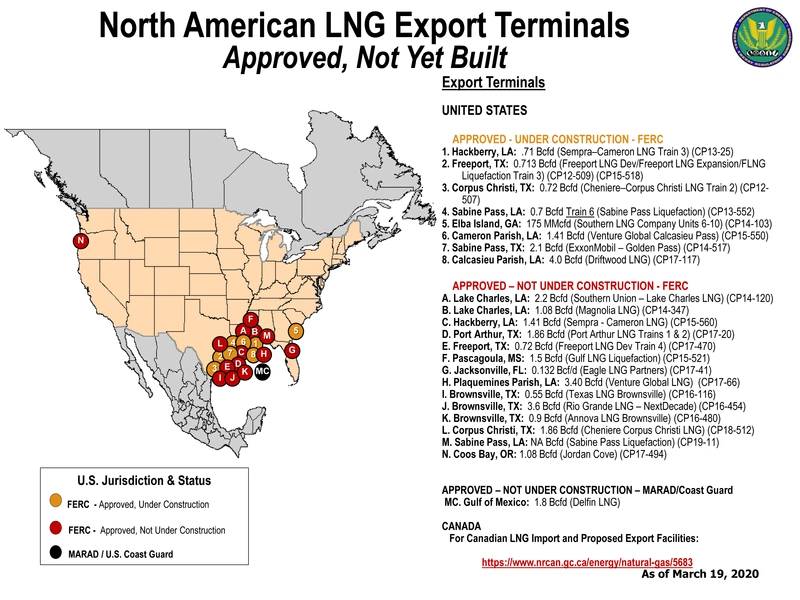 (Image: FERC)
(Image: FERC)The Sabine-Neches Waterway is one such navigation system confronting new and increased maritime hazards. The Sabine-Neches (S-N) is the United States’ third largest waterway, connecting the Gulf of Mexico with the critical Texas port-energy cities of Port Arthur, Beaumont and Orange.
The S-N is number one for bulk liquid cargo. Refineries there produce 60% of the nation’s commercial jet fuel. Significantly, the waterway is projected to become the largest liquefied natural gas (LNG) exporter in the US.
The Southeast Texas Waterway Advisory Council (SETWAC) is an umbrella, membership organization that includes the publicly designated Sabine-Neches Navigation District (SNND) as well as Coast Guard reps and professional pilots and port and maritime industries.
Fireboats are highlighted in recent SETWAC documents and presentations. In January 2020, for example, a SETWAC Navigation Subcommittee presented its waterway safety assessment for a planned ethane project in Nederland, Texas, between Port Arthur and Beaumont. Overall, the subcommittee judged that project safety risks and future operational risks were acceptable and within the norms of good practice.
Risks, though, increase with activity. Planned shipments (propane and butane) just from the Nederland project go from 20/month in July 2020 to an expected 30/month in July 2021. Vessels are VLECs – “very large ethane carriers” carrying “up to 98,800 cubic meters in addition to crude oil,” the Subcommittee reports. VLECs are currently used on the S-N Waterway. Additionally, the Subcommittee advised that pilot and tug workforces need to expand to keep pace with this project and other waterway developments.
Recall the FERC map (Figure 1) and the concentration of projects. In Beaumont, for example, Martin Midstream Partners (MMP) is planning an LHG (liquified hazardous gas, similar to LNG but not the same) project that will include ultra large ethane carriers (ULEC). ULECs can have capacities around 150,000 cubic meters each. Vessel transits for this MMP project alone are projected to increase from 24 ships per year to 350. Right now, the S-N District has no large fireboats, although there are some privately owned fireboats.
Waterway officials like to point out that 350 transits are just a fraction of total vessel activity. That’s true. But proportion is important. The S-N Waterway, for example, had 57,238 total transits in 2019, but 84% were inland tug and tow operations. LNG/gas carriers made up 2%, around 1,145 transits. Keep in mind the increase forecast just for the MMP project. It may take years to reach maximum activity, but it also takes a while to obtain a fireboat and have it commissioned into service.
At the SETWAC January meeting the Navigation Subcommittee made two recommendations. One, that the Nederland expansion should be approved.
Second: “Given the rapid expansion of NGL facilities and traffic along the SNWW, all efforts should continue within the local maritime community to add purpose designed and built marine firefighting assets along with appropriately trained personnel. The committee especially emphasizes the need for those companies and terminals operating oil and gas facilities (such as Sun/ETP) to promote and lead this important safety effort.”
What’s happened since that recommendation was made last January?
Some initial next steps were reportedly started by an existing regional safety working group.
One move was to contact officials at Port Houston, which has three fireboats in service along the Houston Ship Channel. S-N officials wanted advice and recommendations based on Port Houston’s experience. What was that advice? Hard to tell. S-N officials would not provide details about the meetings and Houston officials did not respond to inquiries.
Bottom line: this all remains unsettled. Larry Fountain is District Operations Manager for the Sabine Neches Navigation District. “We really haven’t made any progress on furthering the fire boat,” he said, “due largely to the COVID pandemic.” There is no timeline to complete this investigatory work. Funding issues are unresolved. Apparently, there was initial discussion about using some of the revenue from the S-N vessel transit fee to pay for new equipment and, of course, ongoing personnel and operating costs.
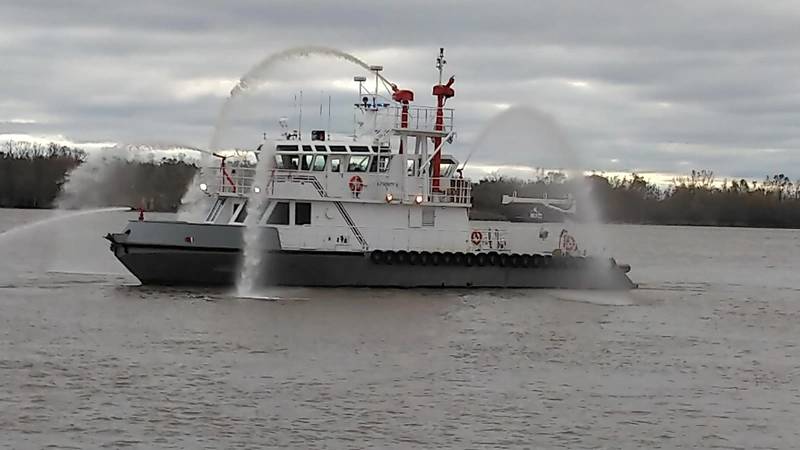 (Photo: Port of Plaquemines)
(Photo: Port of Plaquemines)Now consider the Port of Plaquemines, on the Mississippi, 20 miles south of New Orleans. Plaquemines has significant fireboat capabilities, ready 24/7. The Port has two 57-foot vessels called Authority I and Authority II, each crewed by two firefighters and ready to go in 2-3 minutes. These boats started service in 2015 and 2016. They replaced older, smaller versions from the 1970s. The newer boats are faster, they can pump 6,000 gallons per minute, have remote firefighting operations and positive pressure cabins.
A third vessel, the Authority III, is a 90-footer, crewed by three firefighters. Response time is 5 minutes.
Crews are all maritime certified. All Captains have USCG 100-ton licenses.
Plaquemines fireboat decisions were made in response to the kind of energy-safety issues that Sabine-Neches is confronting. Donald Durr, Director of Security & Vessels for Plaquemines Port, said port officials wanted increased capacity to respond to potential emergencies at refineries and petroleum and chemical plants. A top operating concern was an upgrade in pumping, which the A-3 delivers: 15,000 gallons per minute, a 400-foot reach and carrying 1,000 gallons of foam. Another concern: a larger rescue platform. The A-3 was built in 2005 by Conrad Shipyard in Louisiana.
Durr said that more than 7,000 vessels transit Plaquemines annually. The Port District has 88 miles of deep water river. Tariffs provide the money to pay for fireboat operations. The port has mutual aid agreements with landside communities. Durr said Plaquemines’ annual budget for fireboat operations is about $2 million.
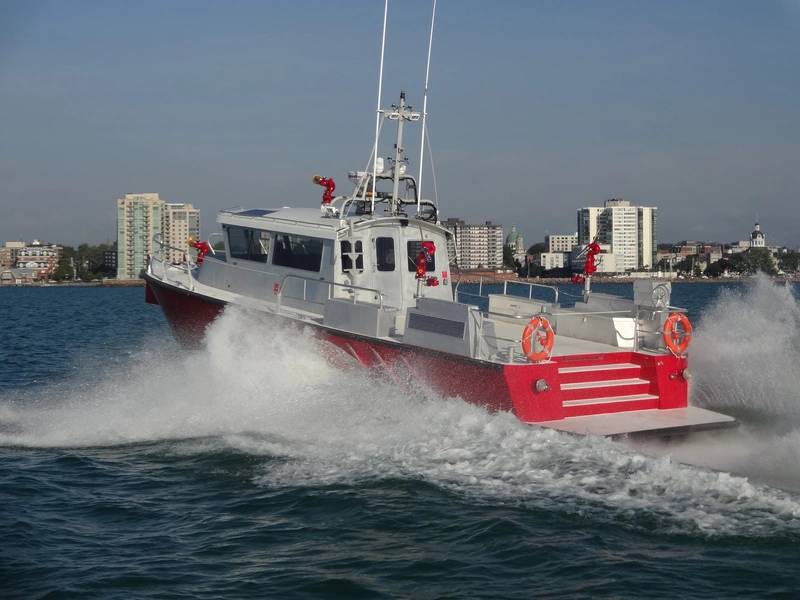 (Photo: MetalCraft Marine)
(Photo: MetalCraft Marine)A builder’s perspective
Bob Clark is Contracts Manager for MetalCraft Marine, a major fireboat manufacturer with facilities in the U.S. and Canada. MetalCraft’s extensive portfolio includes a diverse range of custom fire and rescue vessels. Clark was asked for his perspective on the fireboat market as he monitors emerging issues related to portside energy developments vis-à-vis the difficult decisions about expensive fireboats and related costs.It’s Clark’s view that the market for big fireboats is somewhat stagnant right now. He foresees more growth in demand from smaller public entities, e.g., municipalities and port or safety districts. “The biggest buying decision for the buyers right now,” Clark said, “seems to be budget driven. Even our 36s, 40s and 50s are all being sold at lower dollars.”
Regarding the safety and hazardous issues presented by new port energy developments Clark commented that port officials that he’s been in contact with “are all over the map” regarding interests, concerns and questions about fireboats. He said that MetalCraft is “selling more boats with Purple K agents” (material used to fight LNG fires). In addition, interest in big fireboats ticked upwards after recent port and harbor disasters, such as the one that struck the U.S. Navy’s Bonhomme Richard in San Diego in July.
About 15 years ago, in the U.S., the Department of Homeland Security and FEMA provided rather generous funding and terms to help municipalities purchase fireboats. New York City’s Fireboat 343 and its sister fireboat the Fire Fighter II, for example, both placed in service in 2010, were largely paid for by Homeland Security grants. Each vessel cost $27 million.
In the last five years, those federal funds were cut way back. Still, that money remains important, Clark said, particularly FEMA grants for larger ports considering fireboats. He also noted that in the booming economy pre-COVID smaller municipalities were relatively flush and that, at least for MetalCraft, fireboat orders were strong. Since COVID’s economic hits, however, municipal coffers are far less secure, and Clark said that local governments are avoiding any preventable debt. He added that a new stimulus package could recharge big-ticket orders otherwise standing ready.
Clark was asked about the kind of fireboats currently drawing interest from officials. He said MetalCraft’s FireStorm 50, recently purchased by Miami City, Fla.; Alexandria, Va. and overseas by Kuwait, exemplifies the kind of vessel that gets officials’ interest. Attractive features are speed, high maneuverability and pumping capacity and options for CBRN capabilities.
Clark said that fire officials maintain detailed, long range plans for decisions about new or replacement fireboats. A high priority is placed on vessels with innovative, multimission platforms maximizing alignment with specific needs in individual ports.
He commented further: among ports, this is a nonstop effort. Officials know that when they forward a “yes” decision to the green-eyeshade team in accounting, it’s got to be for the right piece of equipment.
 (Photo: MetalCraft Marine)
(Photo: MetalCraft Marine) -
- Lessons From Losses: Removing Insurance Ambiguity Maritime Logistics Professional, Q2 2013 #18
your General Liability policy, right? Well, maybe. One area that marine contractors need to pay particular attention to is their General Liability insurance policy. Coverage for Completed Operations Liability provides insurance for claims resulting after a construction project is completed. This coverage
-
- Shipowners In Hong Kong Welcome Canadian Moves To Offer Tax Incentives Maritime Reporter, Apr 1991 #71
has are geographical proximity, a Chinese society and well-established transport and telecommunications bases. In what is seen as an insurance policy against China's takeover of Hong Kong in six-and-a-half years, a great many Hong Kong people have established residence in Canada in
-
- “Minor” Incident Sends Mariner Down S&R Rabbit Hole Marine News, Oct 2019 #45
, the licensed-insured mariner was at least spared the over $32,000 six-month cost of his legal representation which was fully paid by his license insurance policy.Once again proving that, while the twists and turns of any marine casualty investigation and prosecution can indeed be very unpredictable, what
-
- New Alarm Reduces Boiler Failures, Diesel Failures And Repair Costs Maritime Reporter, Sep 15, 1985 #34
engines used in this class of vessel. Shipowners and diesel engine manufacturers interested in obtaining further information on this "inexpensive insurance policy," should Circle 62 on Reader Service Car
-
- Real Time, On-line Credit Services Offered Maritime Reporter, Feb 2001 #14
months, OceanConnect.corn's customers repeatedly asked if OceanConnect.com could provide real-time, online credit services. Realtime, global credit insurance never existed before. It had to be invented. It is the advent of the Internet that makes it possible. OceanConnect.com CreditSolutions is a revolutiona
-
- Making the Case for Diesel Outboards Marine News, Jun 2020 #37
seeking the simplicity of installation and the ease of service/repair of an outboard. “It reduces their risk of downtime so they almost see it as an insurance policy,” he explains.Mahendra says diesel outboards combine the endurance, torque and fuel use of inboard stern drives with the flexibility and replicability
-
- Bridge Heights Are Not Guesswork: Accuracy Is Imperative Marine News, Oct 2020 #20
, yet painful, decision was to accept the suspension with probation offer.Because he had opted for income protection when purchasing his license insurance policy, the pilot received his insured wages for the duration of his suspension, but no amount of money could compensate the hit to his professional
-
- Wasted Words: Post-casualty Apologies Are ‘Sorry’ Excuses Marine News, Dec 2020 #10
it a very hollow victory for the hard-working professional mariner had he not had the forethought to protect himself and his career with a license insurance policy which fully paid all the legal costs to defend his license
-
- Bridging the Trip Preparation Gap Marine News, Sep 2013 #20
prudent, yet painful, decision was to accept the suspension with probation offer. Because he had wisely opted for income protection on his license insurance policy, he received his insured wages for the duration of his suspension, but no amount of money could compensate the hit to his professional reputation
-
- Manage and Mitigate Risk on the Water Marine News, Apr 2016 #26
owner for injury or death resulting from an accident occurring on the navigable waters of the United States. Workboat owners need to make sure their insurance policy covers potential liability under either the Jones Act or the USL&H, in case icy conditions result in crewman harm. Additionally, workboat
-
- Inland Marine Insurance: Assuring Property and Goods Move Forward Marine News, Sep 2017 #26
processing, packaging, consolidation, inventory control, transportation, warehousing and data management, more efficiently and effectively using one insurance policy form. XL Catlin’s Logistics Services Coverage Solutions, for instance, is designed for sophisticated and complex logistics companies and provides
-
 )
April 2024 - Maritime Reporter and Engineering News page: 43
)
April 2024 - Maritime Reporter and Engineering News page: 43“The industry is an ecosystem which includes owners, managers, mariners, shipyards, equipment makers, designers, research institutes and class societies: all of them are crucial,” – Eero Lehtovaara, Head of Regulatory & Public Affairs, ABB Marine & Ports All images courtesy ABB Marine and Ports provi
-
 )
April 2024 - Maritime Reporter and Engineering News page: 41
)
April 2024 - Maritime Reporter and Engineering News page: 41have Machine Vision shipowners, and we are also seeing in- for responding to challenging situations. Groke Pro is the ? rst machine vision terest from insurance companies. In Groke Pro was not designed to re- solution to obtain Innovation Endorse- high-risk situations, a recording of im- place crew on board
-
 )
April 2024 - Maritime Reporter and Engineering News page: 15
)
April 2024 - Maritime Reporter and Engineering News page: 15a judicious selection of approaches and treatment a return on The Author investment can be realized. Inspection of the treatment installations is the “insurance” Fischer required to ensure that all the effort going into a quiet ves- Raymond Fischer (pictured) and Leonid Boroditsky have been involved with
-
 )
April 2024 - Maritime Reporter and Engineering News page: 13
)
April 2024 - Maritime Reporter and Engineering News page: 13from gasoline to methanol, but compared to just buying an EV After some pondering, I think I can reduce it to this logi- today that is a pointless exercise. It would actually make more cal sequence: sense to buy a plug-in hybrid that is con? gured for methanol It is the carbon. We want zero carbon as
-
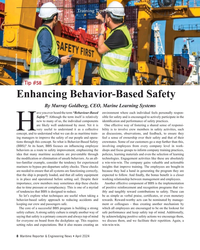 )
April 2024 - Maritime Reporter and Engineering News page: 8
)
April 2024 - Maritime Reporter and Engineering News page: 8Training Tips for Ships © By tuastockphoto/AdobeStock Tip #58 Enhancing Behavior-Based Safety By Murray Goldberg, CEO, Marine Learning Systems ave you ever heard the term “Behaviour-Based environment where each individual feels personally respon- Safety”? Although the term itself is relatively sible for
-
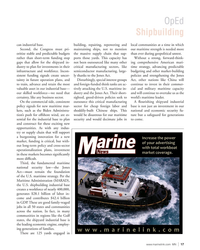 )
April 2024 - Marine News page: 17
)
April 2024 - Marine News page: 17OpEd Shipbuilding can industrial base. building, repairing, repowering and local communities at a time in which Second, the Congress must pri- maintaining ships, not to mention our maritime strength is needed more oritize stable and predictable budgets the massive supply chain that sup- than ever
-
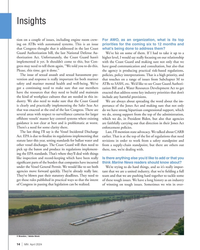 )
April 2024 - Marine News page: 14
)
April 2024 - Marine News page: 14Insights tion on a couple of issues, including engine room crew- For AWO, as an organization, what is its top ing on ATBs with automated systems. This is an issue priorities for the coming six to 12 months and that Congress thought that it addressed in the last Coast what’s being done to address them? Gua
-
 )
April 2024 - Marine News page: 13
)
April 2024 - Marine News page: 13Q&A We’ve still got some work to do. Despite the new guid- Looking across the industry, what are some ance, we are seeing differences in the way that the Coast other important regulatory issues that AWO is Guard is applying crewing and life-saving requirements to currently paying attention to? ATBs from
-
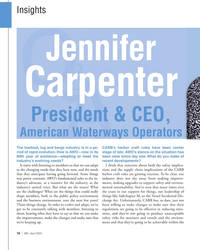 )
April 2024 - Marine News page: 10
)
April 2024 - Marine News page: 10Insights Jennifer QQQQQQQQQAAA & Carpenter President & CEO, American Waterways Operators The towboat, tug and barge industry is in a pe- CARB’s harbor craft rules have been center riod of rapid evolution. How is AWO—now in its stage of late. AWO’s stance on the situation has 80th year of existence—adapt
-
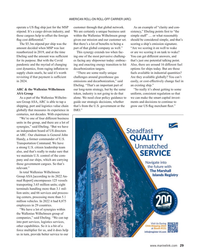 )
February 2024 - Maritime Reporter and Engineering News page: 29
)
February 2024 - Maritime Reporter and Engineering News page: 29AMERICAN ROLL-ON ROLL-OFF CARRIER (ARC) operate a US ? ag ship just for the MSP customer through that global network. As an example of “clarity and con- stipend. It’s a cargo driven industry, and We are certainly a unique business unit sistency,” Ebeling points ? rst to “the those cargoes help to
-
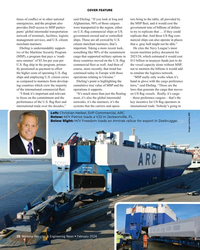 )
February 2024 - Maritime Reporter and Engineering News page: 28
)
February 2024 - Maritime Reporter and Engineering News page: 28COVER FEATURE times of con? ict or in other national said Ebeling. “If you look at Iraq and tors bring to the table, all provided by emergencies, and the program also Afghanistan, 98% of those cargoes the MSP ? eet, and it would cost the provides DoD access to MSP partici- were transported to the
-
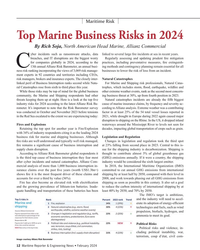 )
February 2024 - Maritime Reporter and Engineering News page: 12
)
February 2024 - Maritime Reporter and Engineering News page: 12manage- businesses to lower the risk of loss from an incident. ment experts in 92 countries and territories including CEOs, risk managers, brokers and insurance experts. The closely inter- Natural Catastrophes linked peril of Business Interruption ranks second while Natu- For Marine and Shipping risk professionals
-
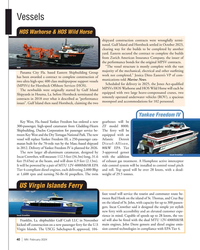 )
February 2024 - Marine News page: 40
)
February 2024 - Marine News page: 40in October 2023, clearing way for the builds to be completed by another yard. Eastern secured the contract to complete the builds from Zurich American Insurance Company, the issuer of the performance bonds for the original MPSV contracts. “The vessel structure is mostly complete with the vast HOS Panama
-
 )
February 2024 - Marine News page: 23
)
February 2024 - Marine News page: 23Passenger Vessel Safety occur on a sightseeing vessel or an Ohio River dinner cruise? This contrast between speci? c – sometimes very speci? c – and general comes to mind when considering the numerous safety advisories pertaining to recent amphibious DUKW boat tragedies or the 2019 Conception dive boat
-
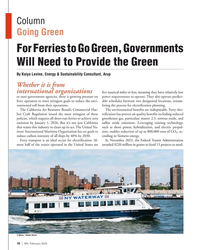 )
February 2024 - Marine News page: 16
)
February 2024 - Marine News page: 16Column Going Green For Ferries to Go Green, Governments Will Need to Provide the Green By Kaiya Levine, Energy & Sustainability Consultant, Arup Whether it is from international organizations ? ve nautical miles or less, meaning they have relatively low or state government agencies, there is growing
-
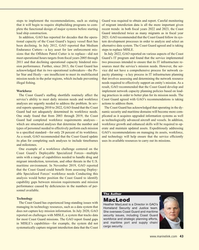 )
January 2024 - Maritime Reporter and Engineering News page: 43
)
January 2024 - Maritime Reporter and Engineering News page: 43steps to implement the recommendations, such as stating Guard was required to obtain and report. Careful monitoring that it will begin to require shipbuilding programs to com- of migrant interdiction data is all the more important given plete the functional design of major systems before starting recent
-
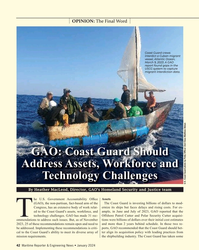 )
January 2024 - Maritime Reporter and Engineering News page: 42
)
January 2024 - Maritime Reporter and Engineering News page: 42OPINION: The Final Word Coast Guard crews interdict a Cuban migrant vessel, Atlantic Ocean, March 9, 2023. A GAO report found gaps in the USCG system to capture migrant interdiction data. GAO: Coast Guard Should Address Assets, Workforce and Technology Challenges U.S. Coast Guard photo by Petty
-
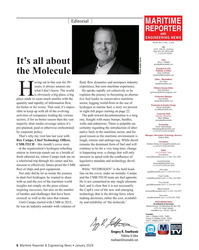 )
January 2024 - Maritime Reporter and Engineering News page: 6
)
January 2024 - Maritime Reporter and Engineering News page: 6Editorial MARITIME REPORTER AND ENGINEERING NEWS M A R I N E L I N K . C O M HQ 118 E. 25th St., 2nd Floor New York, NY 10010 USA T +1.212.477.6700 CEO John C. O’Malley It’s all about [email protected] President & COO Publisher & Editor Greg Trauthwein the Molecule Photo Justin Zurre trauthwein@ma
-
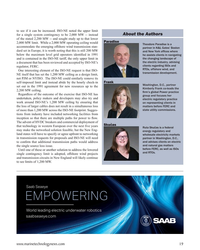 )
November 2023 - Marine Technology Reporter page: 19
)
November 2023 - Marine Technology Reporter page: 19to see if it can be increased. ISO-NE noted the upper limit About the Authors for a single system contingency to be 2,000 MW -- instead of the stated 2,200 MW -- and sought study up to that lower Paradise 2,000 MW limit. While a 2,000 MW operating ceiling would Theodore Paradise is a accommodate the
-
 )
November 2023 - Marine Technology Reporter page: 18
)
November 2023 - Marine Technology Reporter page: 18LEGAL BEAT OFFSHORE WIND point in between, is an at least hourly calculation involving ue? ed natural gas gasi? cation facility, and the region’s two a control-to-control room check. The 1,200 MW value does remaining nuclear plants, Seabrook in New Hampshire and not appear in the 1991 agreement, but is
-
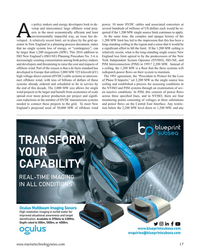 )
November 2023 - Marine Technology Reporter page: 17
)
November 2023 - Marine Technology Reporter page: 17s policy makers and energy developers look to de- power, 10 more HVDC cables and associated converters at velop and interconnect large offshore wind proj- several hundreds of millions of US dollars each would be re- ects in the most economically ef? cient and least quired if the 1,200 MW single source
-
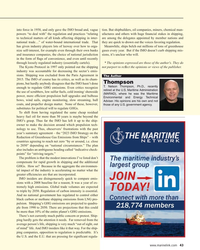 )
December 2023 - Maritime Reporter and Engineering News page: 43
)
December 2023 - Maritime Reporter and Engineering News page: 43of tons of greenhouse nize self-interest, for example even through their own banks gases every year. But if the IMO doesn’t curb shipping mis- and insurance companies, the choice of national jurisdiction sions, it’s unclear who will. in the form of ? ags of convenience, and even until recently through
-
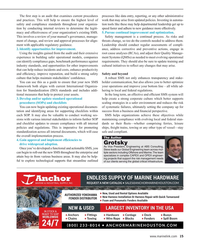 )
December 2023 - Maritime Reporter and Engineering News page: 15
)
December 2023 - Maritime Reporter and Engineering News page: 15The ? rst step is an audit that examines current procedures processes like data entry, reporting, or any other administrative and practices. This will help to ensure the highest level of work that may arise from updated policies. Investing in automa- safety and compliance standards throughout your
-
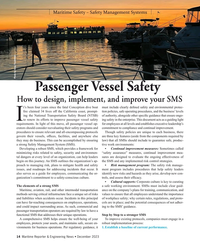 )
December 2023 - Maritime Reporter and Engineering News page: 14
)
December 2023 - Maritime Reporter and Engineering News page: 14Maritime Safety – Safety Management Systems Photo by Greg Trauthwein Passenger Vessel Safety How to design, implement, and improve your SMS t’s been four years since the fatal Conception dive boat must include clearly de? ned safety and environmental protec- ? re claimed 34 lives off the California coast
